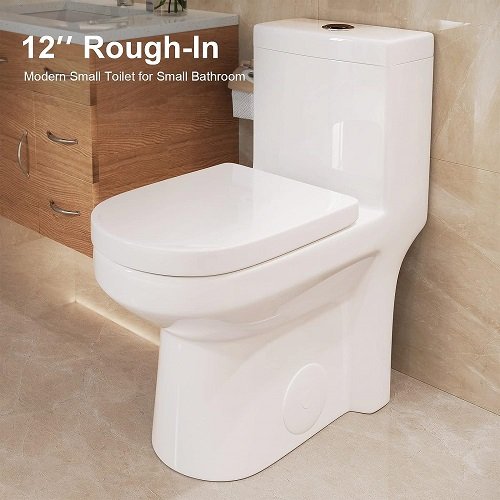If you’ve ever encountered the enigmatic and unsettling issue of black sediment buildup in your toilet bowl, you’re not alone. The sight of these dark intruders can leave you pondering their origins and pondering how to restore your throne to its rightful glory.
Black sediment or discoloration in a toilet bowl can be caused by various factors, including mineral deposits, mold, or bacteria. Here are effective methods to remove black sediment from a toilet bowl:
- Toilet Bowl Cleaner
- Baking Soda and Vinegar
- Pumice Stone
- Toilet Brush and Elbow Grease
- Vinegar and Baking Soda Paste
- Lemon Juice and Salt
- Hydrochloric Acid-Based Cleaner (Caution Required)
Always follow safety precautions when using cleaning products, especially those that contain strong chemicals. Proper ventilation and protective gear (gloves and eye protection) are essential. Now, buckle up as we delve into these solution in more detail.
Causes Of Black Sediment in Toilet Bowls
Imagine this: you step into your bathroom, ready to face the day, only to be greeted by an unwelcome visitor—a pool of black sediment in your toilet bowl. It’s as if a scene from a mystery movie has sprung to life in your bathroom. However, this is no thriller; it’s a common and baffling issue that many of us have faced.
But why is it important to tackle this issue head-on? It’s not just about aesthetics; maintaining a clean and hygienic toilet bowl is paramount for your overall well-being. Who wants to confront a sinister-looking substance every time they answer nature’s call?

Mineral Deposits and Mold
Identifying the root cause is akin to solving a riveting mystery—it’s the essential first step toward a cleaner and more inviting bathroom experience. Mineral deposits, resembling small dark particles, are often the culprits behind the black sediment phenomenon. These deposits can originate from the minerals present in your water supply. Hard water, laden with minerals like calcium and magnesium, can cause these deposits to accumulate over time.
Moreover, mold and bacteria love to flourish in moist environments. A combination of stagnant water and inadequate cleaning can lead to their unholy alliance, resulting in black sediment. So, the next time you encounter this unwelcome visitor, remember that it’s likely a team effort involving minerals, mold, bacteria, and even the water itself.

How to Remove Black Sediment in Toilet Bowl
Now that we’ve identified the perpetrators, it’s time to arm ourselves with the necessary tools and materials. Think of them as your trusty companions in this crusade against black sediment. Rubber gloves, your loyal toilet brush, vinegar, baking soda, and perhaps even a commercial toilet cleaner will be your allies.
However, let’s not overlook safety—proper ventilation is paramount, especially when working with cleaning agents that could trigger a coughing fit if inhaled directly.
Here are effective methods to remove black sediment from a toilet bowl:
- Toilet Bowl Cleaner:
- Start with a commercial toilet bowl cleaner that contains bleach or hydrogen peroxide. Follow the product’s instructions for application.
- Baking Soda and Vinegar:
- Sprinkle baking soda into the toilet bowl, and then pour vinegar over it. Allow the mixture to sit for about 15-20 minutes. The chemical reaction can help break down stains and sediment.
- Scrub the bowl with a toilet brush and flush to rinse away the residue.
- Pumice Stone:
- Use a pumice stone designed for cleaning toilets. Gently scrub the black sediment or stains. Be cautious not to scratch the porcelain surface.
- Rinse the toilet bowl thoroughly to remove any debris.
- Toilet Brush and Elbow Grease:
- Sometimes, the most effective method is to scrub vigorously with a toilet brush and a toilet bowl cleaner. Ensure you get into all the nooks and crannies.
- If necessary, repeat the scrubbing process several times until the sediment is gone.
- Vinegar and Baking Soda Paste:
- Create a paste by mixing baking soda and white vinegar. Apply the paste to the stained areas in the toilet bowl and let it sit for a few hours or overnight.
- Scrub the toilet bowl with a toilet brush and flush to rinse.
- Lemon Juice and Salt:
- Sprinkle salt in the toilet bowl and then squeeze lemon juice over it. Let it sit for a while (30 minutes to an hour) before scrubbing and flushing.
- Hydrochloric Acid-Based Cleaner (Caution Required):
- For severe mineral deposits, you can use a toilet bowl cleaner that contains hydrochloric acid. Be extremely cautious when handling these products and follow all safety instructions on the label. Proper ventilation and protective gear are essential.
- Apply the cleaner according to the instructions, scrub the bowl, and flush multiple times to ensure thorough rinsing.
- Regular Cleaning Maintenance:
- To prevent black sediment buildup in the future, clean your toilet regularly. Regular cleaning helps prevent stains and buildup.
- Check Water Quality:
- Sometimes, black sediment can be caused by issues with your water supply. Consider having your water tested to check for high levels of minerals, which could be contributing to the problem. Installing a water softener or filter may help.
- Consult a Professional:
- If the black sediment issue persists despite your efforts, or if you suspect a plumbing problem, it’s best to consult a professional plumber who can assess and address the issue.
Extra Tips for Removing Black Sediment in Toilet Bowl
Allow me to share my own trials and triumphs as we navigate the treacherous waters of toilet bowl cleaning.
The Regular Cleaning Regimen
Think of this as your daily armor, much like brushing your teeth to fend off cavities. Regular cleaning is the sentinel guarding against sediment buildup. Devoting a few minutes each week to mild cleaners will help you stave off future issues. Consider it a small investment of time to maintain a sparkling throne.
Dissolving the Mineral Menace
I recall a particularly fierce encounter with tenacious mineral deposits that had turned my toilet bowl into a battleground of sediment. My weapon of choice? Acidic cleaners! Whether it’s vinegar or a commercial toilet cleaner, these substances work their magic by dissolving mineral deposits, enabling you to wipe away the nefarious residue. However, a word of caution: when dealing with acidic substances, safety goggles and gloves are your steadfast allies.
Annihilating Mold and Bacteria
Mold and bacteria—the mischievous duo that thrive in the shadows of your bathroom. To conquer them, I turned to the powerhouses of cleanliness: bleach and hydrogen peroxide. Dilution is the key here—never underestimate the importance of following proper guidelines. With the right proportions, you can eliminate these unsavory characters and bid farewell to the black sediment they propagate.
Conquering Stubborn Hard Water Stains
Picture this: unyielding hard water stains clinging to your toilet bowl, reminiscent of stains on a favorite shirt. The solution? Citric acid or lemon juice. Imagine these acidic heroes dismantling the stains’ defenses, rendering them vulnerable to your scrubbing efforts. Patience is your ally here—allow the acid to work its magic before you unleash your scrubbing prowess.

The Baking Soda Enchantment
As we navigate our cleaning odyssey, baking soda emerges as a potent ally. Picture this as a rejuvenating spa treatment for your toilet bowl. By creating a paste using baking soda and water, you can tackle those persistent stains and sediment. Armed with a scrubbing brush, embark on a mission to restore your throne’s former glory. It’s a process that not only cleans but invigorates.
Fortifying Against Future Intrusions
Victory achieved, the black sediment banished, but how do you prevent its return? Think of this section as your playbook for preventative measures. Regular cleaning routines form the frontline of defense, but consider water softeners if hard water plagues your area. Plumbing issues? Address them promptly to thwart future surprises.
Knowing When to Enlist the Experts
There are instances when the enemy proves more formidable than anticipated. In such cases, calling in the professionals—plumbers or cleaning services—is the prudent choice. If the situation appears beyond your expertise, don’t hesitate to make the call. Signs of more serious underlying issues should never be taken lightly, and sometimes it’s best to entrust the challenge to those with specialized knowledge.
A Regal Restroom Renaissance
And so, esteemed adventurers, we’ve traversed the landscape of black sediment, armed with vinegar, baking soda, and a resolute toilet brush. Through trials and tribulations, we’ve learned that routine maintenance, the right materials, and a dash of patience can transform a tarnished throne into a gleaming sanctuary.
Remember, the pursuit of a clean and hygienic toilet bowl isn’t merely a matter of appearances—it’s about fostering a comfortable and inviting space for your everyday rituals. So, with renewed vigor, embark on your journey to banish black sediment. Your porcelain throne awaits a renaissance, and it’s up to you to usher it in with flair and dedication!







